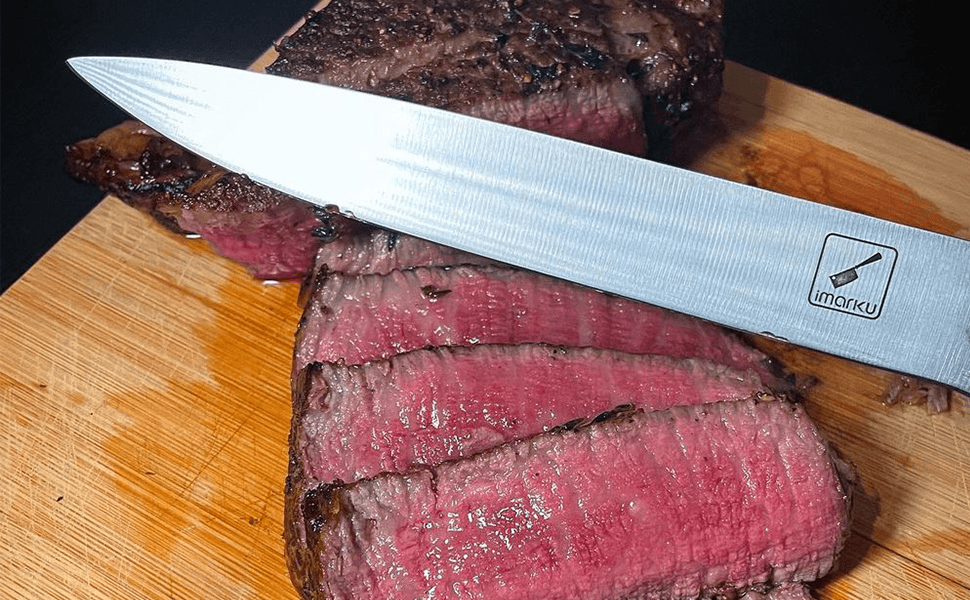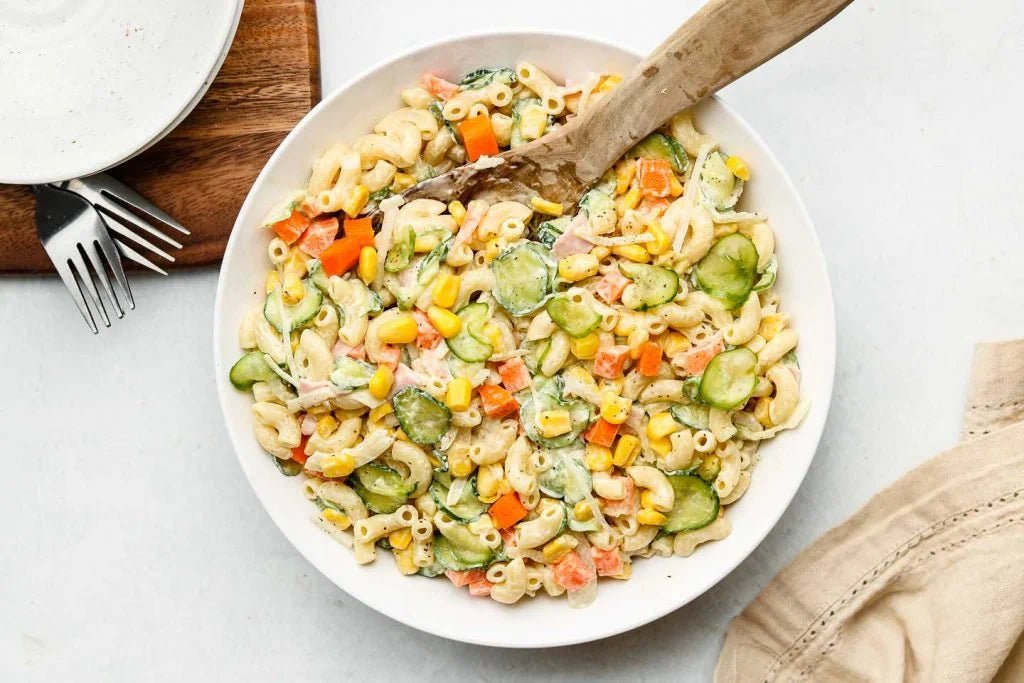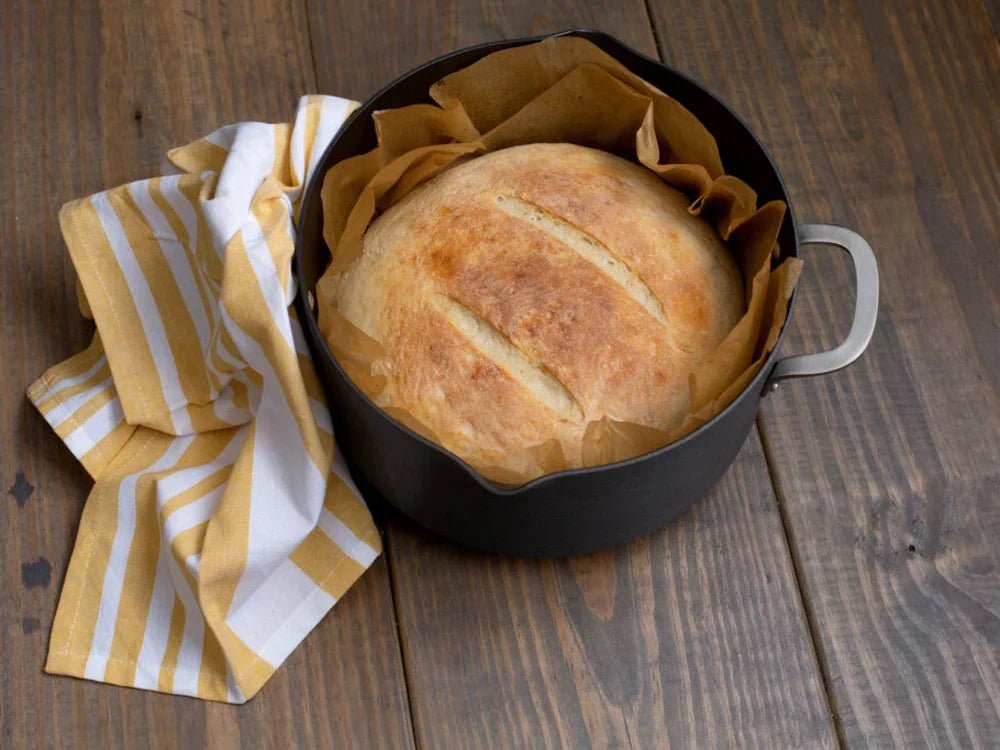TABLE OF CONTENTS
A well-equipped kitchen needs only three knives: a chef's knife, serrated knife and a paring knife. They will do 90% of the work. And that leftover 10%? That's the area where a brisket knife lurks.
With some specialty knives, you can still use one of the three staples instead. However, the results can be subpar. And, as any brisket lover knows, that's unacceptable.
So, today we'll talk about brisket knives. We'll see if you need one, what to look for when picking the best knife for slicing brisket, and everything else you may need to know about this topic.

What Is A Brisket?
Brisket is one of the cheapest cuts of beef that sits right under the chuck, above the shank, and next to the plate. It prefers low and slow cooking methods since it's pretty fibrous.
The ideal doneness sits between 195 and 200 degrees Fahrenheit. It's cut into two sections: the leaner first cut and the fatty second cut.
This piece of beef usually ends up as smoked brisket, pastrami, corned beef, or in pho.
What Is A Brisket Knife?
A brisket knife is a special slicing knife suitable for trimming the fat and gristle off of brisket and slicing it after it's cooked.
It's usually longer than an average chef's knife to allow long and smooth movements. We need those when we're removing thin layers of fat and when we're trying to produce perfect and even slices.
The edge is smooth as not to create a jagged texture. And the blade usually has grooves to prevent sticking.
Though called a brisket knife, it can also be used for slicing other cooked and uncooked meats, like other cuts of beef, poultry, and fish.

Why Do I Need A Specialist Brisket Knife to Slice Brisket?
Maybe you don't. If you cook brisket only once in a while, this is not a purchase you have to make. However, if you fire up the BBQ or the smoker at least once a week, there is a good reason to make this investment.
A brisket is large and has a big surface-to-mass ratio. When it's cooked, you expect to see a smooth surface and to produce smooth slices. You can't do that using a standard chef's knife.
The best way to prevent uneven cuts is to do them in one smooth motion. A chef's knife is usually too small to do that properly. A bread knife has a longer blade, but the created edge will create that jagged texture we're trying to avoid.
Also, we mentioned that the brisket knives usually feature grooves on the blade. These help a lot when you're trying to glide through the meat and fat since they prevent sticking. Same grooves often appear on some Japanese knives because they make it easier to slice through veggies and fish. But, those knives are also too short, and we come back to the brisket knives again.
Finally, we need to talk about muscle fibers. This part of the animal does more work, so the muscle fibers are very tough. Even when cooked properly, they stay pretty strong. If you use the wrong knife to slice through them, they will pull apart. It won't look like pulled pork, but it won't be a slice of brisket either.
What to Consider When Choosing the Best Brisket Knife
Blade Type
You need to get familiar with a couple of terms to know what you're getting.
First is the straight vs. serrated blade. Straight is very self-descriptive, while serrated is usually the same blade you'll find on a bread knife. We recommend choosing a straight blade. We already talked about why we don't want to use a bread knife, so check that out.
The second is scalloped vs. granton. They both refer to the texture on the side of the blade. Scalloped blades give us the same issue as serrated ones because the texture is right at the edge. When a blade is described as granton, the texture is higher up, and the edge stays smooth.
To sum it up, look for a straight granton blade.
Sharpness
A brisked knife must be razor-sharp. A dull blade is not only an easy way to cause an accident, but it will also tear through the meat and defeat the purpose of getting a specialty knife.
The blade also needs to be easy to maintain. While it's expected that you may have to send out your knives for sharpening, you at least have to maintain that sharpness at home.
Weight
A lightweight knife may be easier to slice with, but the heavier one will provide more stability. This one is subjective and you should pick one that feels the best in your hand.
Length
The most common length for a brisket knife is 10, 12, and 14 inches. The longer, the better, since the length of the blade is what allows us to create even slices.
That being said, a 14-inch blade is not the most practical for most home cooks. So, we recommend sticking to 12 inches since it's easier to store and will still give you the results you're looking for.
Material
Brisket knives are usually made of stainless steel or high carbon stainless steel. The latter ones maintain their sharpness for longer but are very corrosive and need maintenance.
The stainless steel blades are the exact opposite. They are very low-maintenance, but they don't stay sharp for as long.
Handle
The handle must provide a firm and comfortable grip. It needs to be well made and properly attached to the blade. We recommend you skip stainless steel because it's too slippery.
You need to take it for a test drive to make sure that it fits into your hand perfectly. It also needs to feel like it provides enough balance to the rest of the knife.
Brand and Budget
Get the best quality you can afford. The best brisket knife doesn't have to cost as much as a chef's knife, but don't dig through the bargain bin either.
Your best bet is to go for a brand specializing in making knives. It may seem obvious, but there is a big difference between manufacturers that make all kitchenware and the ones that make knives alone. The latter is far more likely to offer outstanding quality at a reasonable price.

imarku’s Best Brisket Knives for Slicing & Trimming - 12" Slicing and Carving Knife
Keeping in mind everything we talked about above, here is our top pick from our lineup. Here's how it ticks all of those boxes.
This is a straight edge granton blade that will ensure smooth and long slices. And since the blade is straight without unusual curves, it's very easy to keep sharp at home. Add that it's made from high carbon steel, the blade will maintain its sharp edge for a very long time.
The downside of that is that it will take a bit more maintenance than a stainless steel knife. After washing, you will have to dry the blade properly and then apply some mineral oil to prevent rust. You will find all of those directions in the package.
Other than that, the length is in the sweet spot at 12 inches. This means that it will perform well and be quite easy to store. It may be a tad too big for some knife block, so we recommend keeping it in a sheath or box or on a magnetic wall mount.
This knife features a pakkawood handle with a blade guard. It's well-balanced, durable, and provides a safe and comfortable grip. Most of our customers find it easy to use and maneuver.
We also love using this knife to slice through deli meats and make thin slices of roasted chicken or turkey.
For heavy-duty prep, our meat cleaver collection is perfect for chopping through thick cuts and bones.
Types of Brisket Knives Available for Slicing
Three types of knives usually pop up when it comes to slicing brisket. First is the one we are talking about, aka a slicing brisket knife, joined by carving and electric knives. Feel free to also add a good chef's knife to the list, especially if it's a 9" Gyuto .
However, one will do a better job than the others. Here's how the brisket hold knife holds up against the direct competition.
Slicing Knife vs. Carving knife
Slicing knives have smooth edges while carving knives are serrated. Both have advantages over the other, and slicing knives are better for cutting brisket and some charcuterie.
The serrated edge of a carving knife is well-suited for cutting through dense and fibrous meats. However, it can't produce those thin slices we are looking for now.
When using a serrated knife, you need to perform a sawing motion. This will squash the meat, and you'll end up with misshapen pieces. Long, smooth slicing motions are the best way to ensure that each piece comes out perfect, so we need a slicing knife for a brisket. For cutting through crusty bread or meats, explore our full range of serrated knives tailored to precision.
Manual Knife vs. Electric Knife
The blades of electric knives are also serrated. However. because they saw through meat a lot faster than a human hand can, there is far less damage. However, they will still leave a jagged pattern on each slice of brisket.
The only advantage an electric knife has over a specialty brisket knife is that it's a multitasker. Still, usability and versatility depend on the quality of the appliance.

How To Trim A Brisket Properly
Before you slice and trim, hone the knife's edge. The benefit of brisket knives is that they are super sharp. However, very sharp edges are more likely to bend and roll to one side, making them dull and difficult to work with. They don't need additional sharpening, just to nudge the edge back into place.
So, it's time for some honing action. You can either use a honing steel or the honing slot in a standard kitchen knife sharpener for this job. If you have neither, fold a sheet of aluminum foil several times, and cut through it a few times. Keep in mind that this is a decent SOS solution, and you still want to invest in honing steel as soon as possible.
Slicing Smoked Brisket
First, slice off the small pointy piece in front. Because of the muscle grain, there is no point in making even slices with a knife. Don't toss them away, though. They are packed with flavor. Call them a chef's treat or add to the next batch of baked beans, your choice.
Then, it's time to slice. An average recommended slice size for a BBQ smoked brisked is the so-called pencil size. In translation, each slice should be the width of the standard H2 pencil. If the piece of meat is tougher or well-done, those slices need to be smaller.
After several slices, you will see fat appearing on the side of the meat. We highly recommend trimming those off before proceeding.
Don't slice more than what you plan on serving. A brisket keeps better when it's kept whole. Read how to slicing smoked brisket like a pro.
Trimming Raw Brisket
You can also use a brisket knife to trim the meat before smoking. There is a lot of personal preference in prepping brisket, but here is what we recommend.
Start by putting a wet paper towel under your cutting board. This will prevent it from slipping and sliding as you work. Make sure the brisket is fridge-cold since this will make your job easier. Then, set the meat in front of you and devise the plan of attack.
Slice the big chunks of fat and gristle first. The gristle will not cook-off, while you want to remove sizeable pieces of fat to prevent the brisket from getting too greasy and spices and marinade from sliding off.
However, don't remove all fat. It will keep the meat tender and juicy during and after cooking. Most of the fat you will remove comes from the bottom of the cut. Trim that layer so it's at most a quarter of an inch thick.
You want it to look like an oversized ribeye on the top side, with that thin layer of fat on the bottom. This will work with most recipes, but feel free to experiment as well.
How to Take Care of My Brisket Knife
Proper storage is vital. Keeping your brisket knife in the drawer or badly made knife block will dull the edge. And as we've seen, we need that edge to stay very sharp.
Suppose the drawer is the only place to keep your knives, use a sheath or the original box to store the knife. This will prevent it from hitting other cutlery and protect the edge.
As for the knife block, it should allow the knife to rest on the back of the blade. The edge and the tip should bear no weight if possible. That means that the block slots should be at an angle, or better yet, pick a magnetic block or wall mount.
It's best to wash your knife by hand, and straight after each use. Even if it's marked as dishwasher-safe, it's better to go old-school to prolong the knife's lifespan.
Use soap and water, and remember to hold the knife by the handle and point it away from you. Leave it to air-dry or dry with a towel completely before storing it away.
All kitchen knives need to go out for sharpening once or twice a year. The same thing goes for the brisket knife. If you use it more than once a week, consider scheduling a sharpening every 6 months. After that, preserve the blade's edge by honing it before each use.
Frequently Asked Questions About Brisket Knives
What Else Can a Brisket Knife Cut?
A brisket knife will cut through all other types of smoked meats (sausages, salami, etc.). You can even use it to carve a turkey or ham during the holidays. But, it's also suitable for cutting through other slippery or watery foods.
You can use a brisket knife to cut tofu, tomatoes, peaches, other fruits and veggies, and even cakes. And if you were looking for the best knife to slice halloumi, this knife can do that job as well.
Can I Sharpen a Brisket Knife at Home?
You can, but we highly recommend taking it to a professional sharpener. A brisket knife's blade has more texture than a standard chef's knife. It's not a job for an amateur.
However, you can keep it sharp by honing the blade before each use. You can do this by using a hooning steel or a standard kitchen sharpener.
I'm Lefthanded. Do I Need a Special Brisket Knife for Lefties?
Probably not. Almost all brisket knives have texture on both sides of the blade, so it doesn't matter which hand holds them.
Our top pick is suitable for both lefties and righties.






















Leave a comment
All comments are moderated before being published.
This site is protected by hCaptcha and the hCaptcha Privacy Policy and Terms of Service apply.